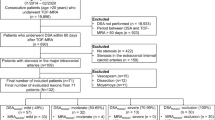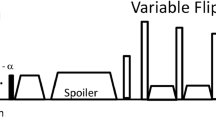Abstract
Objectives
The purpose of this study was to compare the reproducibility and diagnostic agreement of high-resolution vessel wall imaging (HR-VWI) and time-of-flight magnetic resonance angiography (TOF-MRA) with digital subtraction angiography (DSA) to evaluate intracranial arterial stenosis.
Methods
We retrospectively enrolled patients who underwent HR-VWI and TOF-MRA with suspected intracranial artery disease and had DSA results from our institutional imaging database. Two neuroradiologists separately and independently evaluated anonymous image data for the stenotic lesions. DSA was analyzed by two neurointerventionalists and it served as a standard criterion. The reproducibility of these two MR techniques was determined by the intraclass correlation coefficients (ICCs). The diagnostic agreement to DSA was assessed by the concordance correlation coefficients (CCCs).
Results
A total of 246 lesions from 106 individuals were analyzed for stenotic degrees. The total intra-observer and inter-observer reproducibility of HR-VWI was excellent for identifying stenosis and better than of TOF-MRA. The overall concordance of HR-VWI with DSA was excellent with CCC = 0.932, whereas TOF-MRA was 0.694. In addition, HR-VWI could provide additional vessel wall information.
Conclusions
HR-VWI has more advantages over TOF-MRA, such as better reproducibilities and diagnostic agreements with DSA to analyze intracranial arterial stenosis. It provides additional information that helps in clinical diagnosis and management.
Key Points
• High-resolution vessel wall imaging can assess intracranial arterial stenosis with a better reproducibility than TOF-MRA and has a higher diagnostic agreement with DSA.
• High-resolution vessel wall imaging had a higher diagnostic agreement with DSA compared with TOF-MRA.
• Apart from evaluating vascular stenosis, HR-VWI provided additional vessel wall information to help in clinical diagnosis.





Similar content being viewed by others
Abbreviations
- CCC:
-
Concordance correlation coefficient
- DSA:
-
Digital subtraction angiography
- HR-VWI:
-
High-resolution vessel wall imaging
- ICAD:
-
Intracranial atherosclerosis disease
- ICAS:
-
Intracranial atherosclerotic stenosis
- ICC:
-
Intraclass correlation coefficient
- IPH:
-
Intra-plaque hemorrhage
- IR-SPACE:
-
Inversion-recovery sampling perfection with application-optimized contrasts using different flip angle evolution
- TOF-MRA:
-
Time-of-flight MR angiography
- WASID:
-
Warfarin-Aspirin Symptomatic Intracranial Disease
References
Feldmann E, Daneault N, Kwan E et al (1990) Chinese-white differences in the distribution of occlusive cerebrovascular-disease. Neurology 40:1541–1545
Han Y, Qiao H, Chen et al (2018) Intracranial artery stenosis magnetic resonance imaging aetiology and progression study: rationale and design. Brain Behav 8:e01154
Reith W, Berkefeld J, Dietrich P, Fiehler J, Jansen O (2015) Diagnosis and treatment of intracranial stenoses. Clin Neuroradiol 25(Suppl 2):307–316
Liu L, Wong KS, Leng et al (2015) Dual antiplatelet therapy in stroke and ICAS. Neurology 85:1154–1162
Warfarin-Aspirin Symptomatic Intracranial Disease (WASID) Trial Investigators (2003) Design, progress and challenges of a double-blind trial of warfarin versus aspirin for symptomatic intracranial arterial stenosis. Neuroepidemiology 22:106–117
Huang J, Degnan AJ, Liu Q et al (2012) Comparison of NASCET and WASID criteria for the measurement of intracranial stenosis using digital subtraction and computed tomography angiography of the middle cerebral artery. J Neuroradiol 39:342–345
Hurford R, Wolters FJ, Li L, Lau KK, Küker W, Rothwell PM (2020) Prevalence, predictors, and prognosis of symptomatic intracranial stenosis in patients with transient ischaemic attack or minor stroke: a population-based cohort study. Lancet Neurol 19:413–421
Guo C, Shi X, Ding X, Zhou Z (2018) Analysis of radiation effects in digital subtraction angiography of intracranial artery stenosis. World Neurosurg 115:e472–e475
Sandoval-Garcia C, Yang P, Schubert T et al (2017) Comparison of the diagnostic utility of 4D-DSA with conventional 2D- and 3D-DSA in the diagnosis of cerebrovascular abnormalities. AJNR Am J Neuroradiol 38:729–734
Lee JN, Chung MS, Jung SC et al (2016) Comparison of high-resolution MR imaging and digital subtraction angiography for the characterization and diagnosis of intracranial artery disease. AJNR Am J Neuroradiol 37:2245–2250
Park JE, Jung SC, Lee SH et al (2017) Comparison of 3D magnetic resonance imaging and digital subtraction angiography for intracranial artery stenosis. Eur Radiol 27:4737–4746
Ishimaru H, Ochi M, Morikawa M et al (2007) Accuracy of pre- and postcontrast 3D time-of-flight MR angiography in patients with acute ischemic stroke: correlation with catheter angiography. AJNR Am J Neuroradiol 28:923
Liu D, Liu J, Cai Y, Wong KSL, Liu L (2020) Is the future of symptomatic intracranial atherosclerotic stenosis management promising? J Neurol Neurosurg Psychiatry 91:122
Kathuveetil A, Sylaja PN, Senthilvelan S, Kesavadas C, Banerjee M, Jayanand Sudhir B (2020) Vessel wall thickening and enhancement in high-resolution intracranial vessel wall imaging: a predictor of future ischemic events in Moyamoya disease. AJNR Am J Neuroradiol 41:100–105
Kim DK, Verdoorn JT, Gunderson TM et al (2019) Comparison of non-contrast vessel wall imaging and 3-D time-of-flight MRA for atherosclerotic stenosis and plaque characterization within intracranial arteries. J Neuroradiol. https://doi.org/10.1016/j.neurad.2019.05.003
Al-Smadi AS, Abdalla RN, Elmokadem AH et al (2019) Diagnostic accuracy of high-resolution black-blood MRI in the evaluation of intracranial large-vessel arterial occlusions. AJNR Am J Neuroradiol 40:954–959
Kesav P, Krishnavadana B, Kesavadas C et al (2019) Utility of intracranial high-resolution vessel wall magnetic resonance imaging in differentiating intracranial vasculopathic diseases causing ischemic stroke. Neuroradiology. https://doi.org/10.1007/s00234-019-02157-5
Xu W (2019) High-resolution MRI of intracranial large artery diseases: how to use it in clinical practice? Stroke Vasc Neurol 4:102–104
Okuchi S, Fushimi Y, Okada T et al (2019) Visualization of carotid vessel wall and atherosclerotic plaque: T1-SPACE vs. compressed sensing T1-SPACE. Eur Radiol 29:4114–4122
Satyarthee GD (2017) Moyamoya disease: impact of evolving different management approaches to improve overall neurologic outcome. World Neurosurg 102:684–686
Obusez EC, Hui F, Hajj-Ali RA et al (2014) High-resolution MRI vessel wall imaging: spatial and temporal patterns of reversible cerebral vasoconstriction syndrome and central nervous system vasculitis. AJNR Am J Neuroradiol 35:1527–1532
Yang Q, Deng Z, Bi X et al (2017) Whole-brain vessel wall MRI: a parameter tune-up solution to improve the scan efficiency of three-dimensional variable flip-angle turbo spin-echo. J Magn Reson Imaging 46:751–757
Dieleman N, van der Kolk AG, Zwanenburg JJ et al (2014) Imaging intracranial vessel wall pathology with magnetic resonance imaging: current prospects and future directions. Circulation 130:192–201
Teng Z, Peng W, Zhan Q et al (2016) An assessment on the incremental value of high-resolution magnetic resonance imaging to identify culprit plaques in atherosclerotic disease of the middle cerebral artery. Eur Radiol 26:2206–2214
Qiao Y, Zeiler SR, Mirbagheri S et al (2014) Intracranial plaque enhancement in patients with cerebrovascular events on high-spatial-resolution MR images. Radiology 271:534–542
Azuma M, Hirai T, Shigematsu Y et al (2015) Evaluation of intracranial dural arteriovenous fistulas: comparison of unenhanced 3T 3D time-of-flight MR angiography with digital subtraction angiography. Magn Reson Med Sci 14:285–293
Samuels OB, Joseph GJ, Lynn MJ, Smith HA, Chimowitz MI (2000) A standardized method for measuring intracranial arterial stenosis. AJNR Am J Neuroradiol 21:643–646
Tombetti E, Godi C, Ambrosi A et al (2018) Novel angiographic scores for evaluation of large vessel vasculitis. Sci Rep 8:15979
de Boysson H, Boulouis G, Parienti JJ et al (2017) Concordance of time-of-flight MRA and digital subtraction angiography in adult primary central nervous system vasculitis. AJNR Am J Neuroradiol 38:1917–1922
Mandell DM, Mossa-Basha M, Qiao Y et al (2017) Intracranial vessel wall MRI: principles and expert consensus recommendations of the American Society of Neuroradiology. AJNR Am J Neuroradiol 38:218–229
Wu Y, Wu F, Liu Y et al (2019) High-resolution magnetic resonance imaging of cervicocranial artery dissection: imaging features associated with stroke. Stroke 50:3101–3107
Kundel HL, Polansky M (2003) Measurement of observer agreement. Radiology 228:303–308
Timsit C, Soize S, Benaissa A, Portefaix C, Gauvrit JY, Pierot L (2016) Contrast-enhanced and time-of-flight MRA at 3T compared with DSA for the follow-up of intracranial aneurysms treated with the WEB device. AJNR Am J Neuroradiol 37:1684–1689
Zhao DL, Li C, Chen XH et al (2019) Reproducibility of 3.0T high-resolution magnetic resonance imaging for the identification and quantification of middle cerebral arterial atherosclerotic plaques. J Stroke Cerebrovasc Dis 28:1824–1831
Wan L, Zhang N, Zhang L et al (2019) Reproducibility of simultaneous imaging of intracranial and extracranial arterial vessel walls using an improved T1-weighted DANTE-SPACE sequence on a 3 T MR system. Magn Reson Imaging 62:152–158
Cogswell PM, Lants SK, Davis LT, Donahue MJ (2019) Vessel wall and lumen characteristics with age in healthy participants using 3T intracranial vessel wall magnetic resonance imaging. J Magn Reson Imaging 50:1452–1460
Alexander MD, Yuan C, Rutman A et al (2016) High-resolution intracranial vessel wall imaging: imaging beyond the lumen. J Neurol Neurosurg Psychiatry 87:589–597
Kim DK, Verdoorn JT, Gunderson TM et al (2020) Comparison of non-contrast vessel wall imaging and 3-D time-of-flight MRA for atherosclerotic stenosis and plaque characterization within intracranial arteries. J Neuroradiol 47:266–271
Young CC, Bonow RH, Barros G, Mossa-Basha M, Kim LJ, Levitt MR (2019) Magnetic resonance vessel wall imaging in cerebrovascular diseases. Neurosurg Focus 47:E4
Mossa-Basha M, Hwang WD, De Havenon A et al (2015) Multicontrast high-resolution vessel wall magnetic resonance imaging and its value in differentiating intracranial vasculopathic processes. Stroke 46:1567–1573
Mossa-Basha M, Shibata DK, Hallam DK et al (2017) Added value of vessel wall magnetic resonance imaging for differentiation of nonocclusive intracranial vasculopathies. Stroke 48:3026–3033
Alexander MD, de Havenon A, Mossa-Basha M, McNally JS (2020) How far can we take vessel wall MRI for intracranial atherosclerosis? The tissue is still the issue. AJNR Am J Neuroradiol 41:E30–E31
Acknowledgements
The authors thank Song Liu, MD, Department of Radiology, Tianjin Huanhu Hospital and Jian Wang, MD, of Department of Radiology, Tianjin First Central Hospital for image acquisition, and Jinxia Zhu, senior collaboration research scientist, for her professional proof-reading of the entire manuscript.
Funding
This work was supported in part by the National Natural Science Foundation of China (NSFC) (grant number 81871342) and in part by the Spring plan of Tianjin First Central Hospital (grant number 2019CM05).
Author information
Authors and Affiliations
Corresponding author
Ethics declarations
Guarantor
The scientific guarantor of this publication is Shuang Xia.
Conflict of interest
The authors of this manuscript declare no relationships with any companies whose products or services may be related to the subject matter of the article.
Statistics and biometry
No complex statistical methods were necessary for this paper.
Informed consent
Written informed consent was waived by the Institutional Review Board.
Ethical approval
Institutional Review Board approval was obtained.
Methodology
• retrospective
• diagnostic or prognostic study
• performed at one institution
Additional information
Publisher’s note
Springer Nature remains neutral with regard to jurisdictional claims in published maps and institutional affiliations.
Supplementary information
ESM 1
(DOCX 947 kb)
Rights and permissions
About this article
Cite this article
Gong, Y., Cao, C., Guo, Y. et al. Quantification of intracranial arterial stenotic degree evaluated by high-resolution vessel wall imaging and time-of-flight MR angiography: reproducibility, and diagnostic agreement with DSA. Eur Radiol 31, 5479–5489 (2021). https://doi.org/10.1007/s00330-021-07719-x
Received:
Revised:
Accepted:
Published:
Issue Date:
DOI: https://doi.org/10.1007/s00330-021-07719-x




